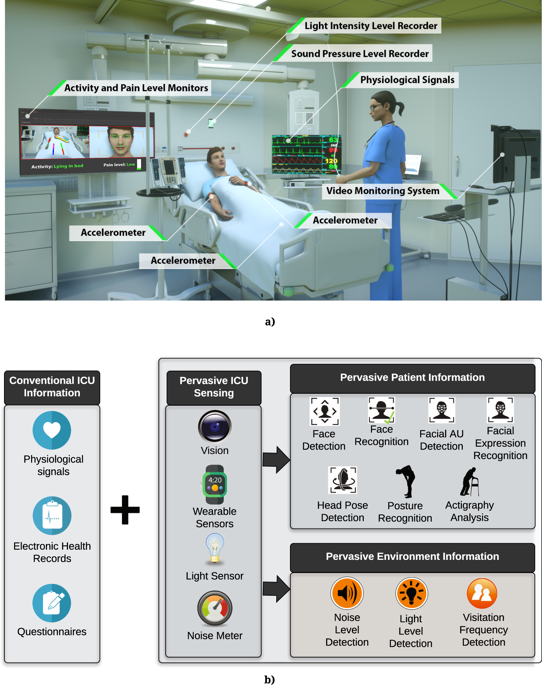Our official English website, www.x-mol.net, welcomes your
feedback! (Note: you will need to create a separate account there.)
Intelligent ICU for Autonomous Patient Monitoring Using Pervasive Sensing and Deep Learning.
Scientific Reports ( IF 3.8 ) Pub Date : 2019-05-29 , DOI: 10.1038/s41598-019-44004-w Anis Davoudi 1 , Kumar Rohit Malhotra 2 , Benjamin Shickel 2 , Scott Siegel 1 , Seth Williams 3, 4 , Matthew Ruppert 3, 4 , Emel Bihorac 3, 4 , Tezcan Ozrazgat-Baslanti 3, 4 , Patrick J Tighe 5 , Azra Bihorac 3, 4 , Parisa Rashidi 1, 2, 4
Scientific Reports ( IF 3.8 ) Pub Date : 2019-05-29 , DOI: 10.1038/s41598-019-44004-w Anis Davoudi 1 , Kumar Rohit Malhotra 2 , Benjamin Shickel 2 , Scott Siegel 1 , Seth Williams 3, 4 , Matthew Ruppert 3, 4 , Emel Bihorac 3, 4 , Tezcan Ozrazgat-Baslanti 3, 4 , Patrick J Tighe 5 , Azra Bihorac 3, 4 , Parisa Rashidi 1, 2, 4
Affiliation

|
Currently, many critical care indices are not captured automatically at a granular level, rather are repetitively assessed by overburdened nurses. In this pilot study, we examined the feasibility of using pervasive sensing technology and artificial intelligence for autonomous and granular monitoring in the Intensive Care Unit (ICU). As an exemplary prevalent condition, we characterized delirious patients and their environment. We used wearable sensors, light and sound sensors, and a camera to collect data on patients and their environment. We analyzed collected data to detect and recognize patient's face, their postures, facial action units and expressions, head pose variation, extremity movements, sound pressure levels, light intensity level, and visitation frequency. We found that facial expressions, functional status entailing extremity movement and postures, and environmental factors including the visitation frequency, light and sound pressure levels at night were significantly different between the delirious and non-delirious patients. Our results showed that granular and autonomous monitoring of critically ill patients and their environment is feasible using a noninvasive system, and we demonstrated its potential for characterizing critical care patients and environmental factors.
中文翻译:

使用普遍传感和深度学习进行自主患者监测的智能 ICU。
目前,许多重症监护指标并不是自动捕获的,而是由负担过重的护士重复评估。在这项试点研究中,我们研究了在重症监护病房 (ICU) 中使用普遍传感技术和人工智能进行自主和精细监控的可行性。作为典型的流行病,我们描述了神志不清的患者及其环境。我们使用可穿戴传感器、光和声音传感器以及摄像头来收集患者及其环境的数据。我们分析收集的数据,以检测和识别患者的面部、姿势、面部动作单元和表情、头部姿势变化、四肢运动、声压级、光强度级和探访频率。我们发现,神志不清的患者和非神志不清的患者的面部表情、四肢运动和姿势的功能状态以及环境因素(包括夜间探视频率、光和声压水平)存在显着差异。我们的结果表明,使用无创系统对危重患者及其环境进行精细和自主监测是可行的,并且我们证明了其在描述危重护理患者和环境因素方面的潜力。
更新日期:2019-05-29
中文翻译:

使用普遍传感和深度学习进行自主患者监测的智能 ICU。
目前,许多重症监护指标并不是自动捕获的,而是由负担过重的护士重复评估。在这项试点研究中,我们研究了在重症监护病房 (ICU) 中使用普遍传感技术和人工智能进行自主和精细监控的可行性。作为典型的流行病,我们描述了神志不清的患者及其环境。我们使用可穿戴传感器、光和声音传感器以及摄像头来收集患者及其环境的数据。我们分析收集的数据,以检测和识别患者的面部、姿势、面部动作单元和表情、头部姿势变化、四肢运动、声压级、光强度级和探访频率。我们发现,神志不清的患者和非神志不清的患者的面部表情、四肢运动和姿势的功能状态以及环境因素(包括夜间探视频率、光和声压水平)存在显着差异。我们的结果表明,使用无创系统对危重患者及其环境进行精细和自主监测是可行的,并且我们证明了其在描述危重护理患者和环境因素方面的潜力。































 京公网安备 11010802027423号
京公网安备 11010802027423号